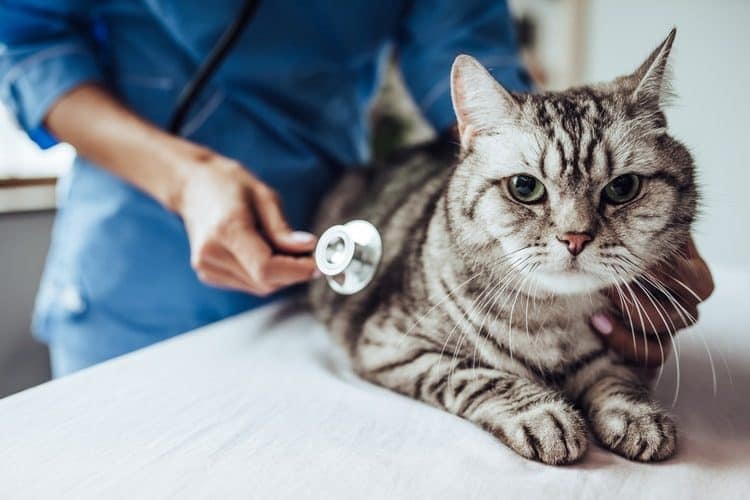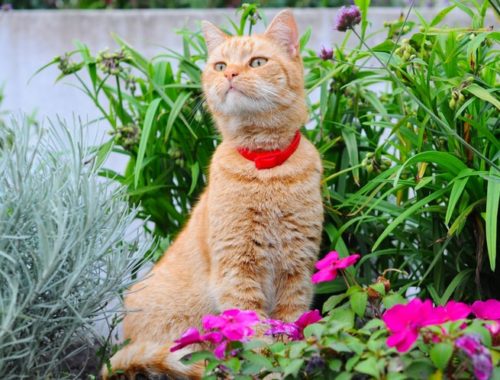Whether you have one, two, three, or a house full of kitties, health insurance for your cat to cover unexpected veterinarian costs can be a life saver, maybe even literally. Reimbursing you for monies spent caring for your cat from an accident or illness, insurance plans can give you some peace of mind when it comes to financially supporting your furries. But how do you know what to look for when selecting cat insurance? We have compiled a list of our favorite cat insurance options for you to compare and have broken down the various key factors to keep in mind when purchasing insurance for your feline family members.

Embrace
- Decreasing deductible
- 90 percent reimbursement
- Reward program for routine care
- Seniors 15+ qualify for limited coverage
Rating 4.7
We looked at a handful of pet insurance companies to sort through the details for you. We liked Embrace pet insurance as our top choice for cats. Embrace covers up to 90 percent of veterinarian costs for unexpected accidents and illnesses, which can help soften the blow of a large, unforeseen vet bill.
In This Article
We researched key factors such as basic coverage, exclusions, limitations, deductibles, reimbursement percentages, and possible discounts. Most cat insurance companies are relatively the same in comparison, but a few stand out for quality or niche reasons.
The Best Cat Insurance Companies
| Editor's Picks | Brand | Rating |
|---|---|---|
| Best Cat Insurance Overall | Embrace Pet Insurance | 4.7 |
| Runner-Up Cat Insurance | Healthy Paws Pet Insurance | 4.6 |
| Best Discount Cat Insurance | Pet Assure | 4.5 |
| Best Cat Insurance for Multiple Cats | Petfirst Pet Insurance | 4.6 |
| Best Cat Insurance with Add-Ons | Trupanion Pet Insurance | 4.6 |
Best Cat Insurance Overall: Embrace Pet Insurance
 Learn More on Embrace Pet Insurance secured website | Average Customer Rating What we like: |
|---|---|
| Monthly Premium | Average of $23 |
| Deductible | $200 to $1,000 |
| Coverage | 70, 80, or 90 percent |
| Age Restrictions | Up to 14 years old Accident-only coverage 15 years and older |
Visit the Embrace Pet Insurance website or get a quote for pet insurance Visit Insurer WebsiteGet Quote | |
Embrace Pet Insurance is a top choice as health insurance for your favorite feline. Covering up to 90 percent of costs associated with accidents, injuries, and illnesses, Embrace’s comprehensive insurance plan is available for cats up to, and including, the age of 14 years. Cats 15 years or older are eligible for accident-only coverage. At whatever age your cat is accepted, insurance coverage is for the rest of his life. You also have the option of adding on coverage for routine care. The policy wait period is 14 days for illness and two days for accidents.
Coverage with Embrace includes dental illness or injury, chronic or congenital conditions, cancer and alternative treatment, rehabilitation, and behavioral therapy. Your kitty is also covered for emergency and specialist care, diagnostic testing, surgery, hospital care, mobility devices, and prescription medications. Embrace features an optional reimbursement reward program for things like wellness exam fees, spay or neuter procedures, grooming, cremation or burial, holistic care, and acupuncture.
Embrace does not cover preexisting conditions, like most pet insurance companies, but does offer to cover what is considered a curable preexisting condition. If your cat currently has a medical condition, but remains both symptom and treatment free from the condition for at least one year, then the condition can be covered on the insurance plan for any future claims. Other exclusions and limitations include breeding, cosmetic procedures, DNA testing, and other extraneous scenarios.
In comparison to the other pet insurance companies we looked at, Embrace is the only one to offer a decreasing deductible. For every year you are not paid from a claim, your deductible decreases by $50. When you sign up for cat insurance, choose from a $200, $300, $500, $750, or $1,000 deductible with a reimbursement limit from $5,000 to $30,000. Pick from 70, 80, or 90 percent reimbursement to further customize your cat’s insurance plan. The optional reward program costs $250 to $650 depending on the level of coverage you’re looking for.
Have more than one cat? Embrace offers a multi-pet discount for those who insure more than one cat. Save 10 percent on each additional pet you add to the plan. Insurance plans average $23 per month for cats. A low reimbursement – 70 percent – with a high deductible – $1,000 (meaning more out of your pocket when the vet bill comes due) is about $9 per month. A high reimbursement with a low deductible (meaning less out of your pocket at the vet) is about $34 per month.
Important Features of Embrace Pet Insurance:
- Reimbursement rates up to 90 percent
- Vanishing deductible
- Optional reward program available
- Accident-only plans for seniors
- Customizable insurance plans
- 10 percent multi-pet discount
Runner-Up Cat Insurance: Healthy Paws Pet Insurance
 Learn More on Healthy Paws Pet Insurance secured website | Average Customer Rating What we like: |
|---|---|
| Monthly Premium | Starting at $15 |
| Deductible | $100, $250, or $500 |
| Coverage | 70, 80, or 90 percent |
| Age Restrictions | 8 weeks old up to 14 years |
Visit the Healthy Paws Pet Insurance website or get a quote for pet insurance Visit Insurer WebsiteGet Quote | |
Healthy Paws Pet Insurance offers health insurance for kittens at least 8 weeks in age and cats up to 14 years old. Insurance plans start at about $14 per month and cover a range of issues from accidents to injuries to illnesses. Insurance coverage includes emergencies, chronic illness, congenital or hereditary conditions, prescription medications, and cancer treatment. Also covered in the cat insurance plans are surgery, x-rays, specialist care, and alternative treatment.
When you sign up for cat insurance with Healthy Paws, your cat’s age helps determine the amount of coverage that’s available. For example, health insurance coverage for a 5-year-old cat costs about $14 to $18 per month, with the option of 70 or 80 percent reimbursement and a choice of a $250 or $500 deductible. A 1-year-old cat also has the option of reimbursement up to 90 percent and a $100 deductible, for a cost at about $12 per month. Healthy Paws doesn’t have a maximum annual or lifetime payout limit.
Pet insurance companies do not cover preexisting conditions, and neither does Healthy Paws. Other exclusions and limitations include preventative care, dental health, exam fees, spay or neuter surgery, training, boarding, and behavioral therapy. You don’t have to wait long for the insurance policy to be in effect – the waiting period is 15 days from the policy’s start date. Claims are typically processed within 10 days, and to speed things along, submit your claims via a snap of your phone. Take a picture of your cat’s veterinarian bill and submit that as your claim form.
Important Features of Healthy Paws Pet Insurance:
- For kittens and cats 8 weeks to 14 years old
- Choice of reimbursement percentage and deductible
- Photo-enabled claim form
- No maximum annual or lifetime limit
- Donates to nonprofit pet organizations
Best Discount Cat Insurance: Pet Assure
 Learn More on Pet Assure Pet Insurance secured website | Average Customer Rating What we like: |
|---|---|
| Monthly Premium | $10 $17 up to four pets $22 more than four pets |
| Deductible | None |
| Coverage | 25 percent |
| Age Restrictions | None |
Visit the Pet Assure Pet Insurance website or get a quote for pet insurance Visit Insurer WebsiteGet Quote | |
A stable, somewhat more predictable, alternative option is the discount plan. It doesn’t work the same way compared to our other picks. Pet Assure, a discount pet insurance for cats, offers you the opportunity to save 25 percent off certain veterinarian services. And unlike our other picks, this insurance plan only works with participating veterinarians. For $10 per month, your cat is covered under any type of circumstance, provided you use a veterinarian that accepts the discount insurance company, Pet Assure. Save 25 percent for things like dental cleanings, routine visits, exam fees, emergency care, hospital stays, and more. It does not cover outsourced lab services or specialists.
Pet Assure accepts all types of animals. So if your cat has a different-species sibling, they can be covered, too. In fact, Pet Assure offers a family plan and an unlimited plan for multi-pet households. For $17 per month, cover up to four pets, and for $22 per month, cover more than four pets. And if you pay your annual insurance policy in full, there’s another discount on top of that. There’s no wait period, so you can use your discounts immediately after you sign up.
With Pet Assure, your cat is covered at any age, and there are no exclusions or limitations. So if your kitty has a preexisting condition, no worries, you still receive a 25 percent discount on qualifying veterinarian services. There are no deductibles or claim forms to bother with – just show your discount card to a participating veterinarian and receive the discount at the time of payment. As part of the discount insurance plan, you and your cat are also enrolled in a lost pet recovery service, free of charge. This health insurance for cats can be used alone or with a more comprehensive insurance plan to help fill in any gaps a more traditional pet insurance plan may have.
Important Features of Pet Assure:
- Accepts all types of animals
- Offers multiple discounts for multiple pets
- Easy to sign up and use
- Only works with participating veterinarians
- Use in conjunction with comprehensive insurance
Best Cat Insurance for Multiple Cats: Petfirst Pet Insurance
 Learn More on Petfirst Pet Insurance secured website | Average Customer Rating What we like: |
|---|---|
| Monthly Premium | Starting at $9 |
| Deductible | Average of $250 |
| Coverage | 65 to 100 percent |
| Age Restrictions | Minimum of 8 weeks old |
Visit the Petfirst Pet Insurance website or get a quote for pet insurance Visit Insurer WebsiteGet Quote | |
If you have multiple cats, you shouldn’t have to choose which one to cover under insurance. Nor should you have to pay through the nose to cover all of them. Most pet insurance companies offer some kind of multi-pet discount, but in comparison, we liked Petfirst Pet Insurance for offering to cover three cats up to the age of 10 years old. With insurance plans starting at about $9 per month, you could pay less than $20 per month for three cats. Save an average of 30 percent with the multi-pet discount, and it’s almost like paying for two cats and the third kitty rides free.
Petfirst offers health insurance for cats, with plans that cover incidents such as emergencies, accidents, illness, surgery, diagnostics, and X-rays. Other coverage includes chronic care, hereditary and congenital conditions, exam fees, prescription medications, and alternative medicine and therapy. To expand your kitty’s coverage, Petfirst also offers five additional plans to help cover the costs of routine care and wellness visits. Under these optional insurance plans – that you get to choose from – routine exams, vaccines, teeth cleaning, spay or neuter surgery, and behavioral training are covered to some degree.
Whether you have an 8-week-old kitten or a senior to insure, both are accepted. There is no age limit for insurance coverage, except when applied to the discount. You get to choose your rate of reimbursement, deductible amount, and maximum annual limit. Choose as low as 65 percent or as high as 100 percent for reimbursement. Deductibles are offered as low as $100, but the average is $250. And though you do not need to set a maximum annual limit, you can cap it between $2,000 and $10,000.
Preexisting conditions are not covered by Petfirst, neither are elective procedures, grooming, supplements, food, or any facet of breeding. There is a short wait period for coverage on accidents – 24 hours or less – and a 2-week wait period for illness. Claims are processed within two weeks, and coverage expands after a 6-month waiting period.
Important Features of Petfirst Pet Insurance:
- Save up to 30 percent with the multi-pet discount
- Customizable insurance plans
- No age limit
- Five additional plans for expanded coverage
- Choice of no maximum annual limit
Best Cat Insurance with Add-Ons: Trupanion Pet Insurance
 Learn More on Trupanion Pet Insurance secured website | Average Customer Rating What we like: |
|---|---|
| Monthly Premium | Starting at $19 |
| Deductible | $0 to $1,000 |
| Coverage | 90 percent |
| Age Restrictions | Up to 14 years old |
Visit the Trupanion Pet Insurance website or get a quote for pet insurance Visit Insurer WebsiteGet Quote | |
Not all pet insurance companies offer additional plans past the main insurance plan. But for the ones that do, the additional coverage aims to help with veterinary care that isn’t covered under the core plan. Trupanion Pet Insurance offers you a few different options for adding on health insurance coverage for your cat, so you can be sure he’s covered for almost anything. From unexpected accidents to routine holistic care, Trupanion reimburses for a wide variety of vet care. But like all other insurance companies, Trupanion does not cover preexisting conditions.
Under the main insurance plan, your cat is covered for things like illness, injury, surgery, disease, cancer treatments, prescriptions, and diagnostics, as well as hereditary and congenital conditions. Add on one of the optional complementary care packages and your kitty is also covered for physical, rehabilitative, and behavioral therapy. This same add-on insurance package includes alternative services such as homeopathy, hydrotherapy, acupuncture, and chiropractic care.
For more expanded coverage, you also have the option of an add-on assistance package that includes boarding fees for your cat if you find yourself hospitalized and unable to care for him. This second package also includes cremation, burial, and advertising and a reward for a lost pet.
Reimbursing 90 percent of eligible costs, Trupanion doesn’t impose an annual maximum limit for payouts, but they do require a 30-day wait period for illness claims. The waiting period for injuries is five days. File and process claims quickly with direct pay – Trupanion pays your vet directly, which is only available with participating veterinarians.
Trupanion health insurance plans for cats cost roughly $19 to $61 per month, depending on the deductible you choose. Deductibles range from nothing to $1,000, and are condition-based, meaning you pay a deductible for each condition you bring your cat in for. But once the deductible is met, that condition is covered for life.
Important Features of Trupanion Pet Insurance:
- Direct pay to veterinarian available
- Multiple add-on packages available
- Condition-based, adjustable deductible
- 90 percent reimbursement rate
- No maximum annual limit
How We Found the Best Cat Insurance Plans
When looking for the best pet insurance plans, we considered a variety of factors that make up health insurance coverage. We looked at the different types of core coverage offered for cats, and whether or not there were any exclusions or limitations attached to the plan. Further, we checked out deductibles, reimbursement rates, and maximum annual limits, along with additional insurance coverage for routine care and multi-pet discounts.
Coverage
Pet insurance companies offer you a variety of coverage options for your kitty. Many insurance plans for cats offer a core plan that covers the unexpected costs that crop up during a pet’s life, like accidents, injuries, and illnesses. Insurance companies differ in the specifics of what is offered in the core plan, but typically coverage includes emergencies, surgery, prescriptions, congenital and hereditary conditions, non-routine dental care, chronic conditions, cancer treatments, diagnostics, and hospital care.
For example, Embrace pet insurance offers to cover your kitty for behavioral therapy in its core package, but Trupanion only offers behavioral therapy in its optional add-on plan. Consider what you need in your insurance plan to adequately cover your kitty’s health.
Exclusions and Limitations
Just like the difference in core insurance plans, the exclusions and limitations also vary by company. While pet insurance companies never cover preexisting conditions, some insurance plans have an amendment to that rule, allowing curable preexisting conditions to eventually be covered after a set amount of time.
For instance, if your kitty is currently being treated for an illness, it won’t be covered under a new insurance plan. However, if you choose an insurance company that allows for curable preexisting conditions, then when your cat recovers from the illness, and remains symptom and treatment free for a specified amount of time, that illness is covered.
An age limit on a pet insurance policy is not uncommon, but the rule is different for each company. The average age limit is 14 years old, but you have the option of choosing a plan that doesn’t set an age limit. Alternatively, some insurance plans offer a limited policy for senior kitties over the age of 14 years.
Deductibles
A deductible is the amount of money you pay out of pocket toward your yearly veterinarian bills before the insurance company pays on a claim. This amount varies from company to company, and ranges anywhere from 0 to as high as $2,500. Typical deductibles are $250, $500, and $1,000. Many insurance plans allow you to choose the deductible you would prefer, with a higher deductible costing a lower premium and vice versa.
One type of deductible, the condition-based deductible, works differently. This deductible is the amount of money you pay out of pocket toward each condition your cat goes to the veterinarian for. Once you have paid the deductible amount for a particular condition, then the insurance company will pay on a claim for that condition in the future.
Reimbursement Rates and Annual Limits
Reimbursement rates and the maximum annual limit differ depending on which pet insurance company you’re looking at. The reimbursement rate is the percentage the insurance company pays toward a claim. So if you have chosen an insurance plan with a reimbursement rate of 80 percent, the insurance company pays 80 percent of the eligible veterinarian costs associated with that plan. Lower reimbursement rates means more money out of pocket for you. Higher reimbursement rates typically mean higher monthly premiums.
The maximum annual limit is the maximum amount of money an insurance company pays out on a policy year. Most of the pet health insurance companies we looked at don’t limit the amount of money they pay out in a policy year.
For example, Healthy Paws, Pet Assure, Trupanion, and Petfirst have no maximum limit for the policy year. In comparison, Embrace and Pumpkin each offer multiple annual limits to choose from.
Optional Insurance Packages
Coverage for cat insurance can go beyond the basic core package that companies offer. Many insurance companies also have optional add-ons to help cover the costs of routine vet care as well. And others offer even more than that to help cover other, maybe less common, animal services. Consider what type of coverage you want for your furry feline.
For instance, Trupanion offers a variety of additional insurance packages, covering everything from holistic care to boarding to cremation. In contrast, Healthy Paws does not offer optional insurance packages for adding on to the core plan. The average cost of an optional insurance package depends on the company, but is anywhere from an extra $15 per month to $35 per month.
Discounts
If you are graced with the presence of multiple cats, then having a multiple-pet discount could help cover the wide range of expenses you might pay out over time. Not all insurance companies offer a discount for multiple pets, but for those that do, the average is 10 percent per additional pet. But check with the insurance company to find out if there is a limit to the number of cats that can be added to a particular plan.
For example, the discount plan, Pet Assure, features a discount of varying levels for any number of pets. Choose the correct plan to accommodate the size of your family and save on your monthly premium.
How to Choose the Best Cat Insurance Company for Your Cat
Finding the right cat insurance company for your favorite feline just takes a little digging and a little know-how. Compare the key features of each pet insurance company to determine the one that will cover your needs the most. Consider the variety of factors offered within each insurance plan, and work within your budget to find the one for you and your kitty, or kitties. Here are a few of the most important factors to consider when comparing cat insurance plans.
Review Covered Conditions and Exclusions
The conditions and illnesses covered by cat insurance plans vary from company to company. For instance, many cat insurance companies don’t cover pre-existing conditions, or conditions that your cat has been diagnosed with or treated for within the previous six or twelve months before coverage began. Most exclude wellness and preventive care, as well, which includes things like your cat’s annual wellness exam and vaccinations.
Compare Monthly or Annual Premiums
Premiums are the amount you pay monthly or annually for your cat’s insurance coverage. Premiums are the most predictable cost and the cost you’ll pay whether you file any claims with your cat’s insurance plan or not, so it’s often the top consideration for pet parents evaluating cat insurance plans. If you’re on a limited budget, a cat insurance plan with a lower premium may work best for you. However, keep in mind that if your cat is injured or gets sick, you’ll likely have to pay a larger deductible before the insurance company’s coverage kicks in, and the portion of expenses covered by the insurance company may be lower (70 percent instead of 90 percent, for example). That means you’ll be faced with higher out-of-pocket costs that you didn’t plan for.
A higher premium often means a lower deductible, higher coverage amount (such as 90 percent instead of 70 percent), or both. That means you’ll have lower out-of-pocket costs should your cat require care. If you’re more comfortable with a regular, planned monthly or annual expense than higher out-of-pocket costs that you didn’t plan for if your cat gets sick or injured, a higher-deductible plan may be the best choice for you.
Your cat’s age, breed, and size can also impact your monthly premiums. Ultimately, finding the right cat insurance plan is about finding the plan with the right balance of monthly premiums, deductibles, and coverage that meets your cat’s needs and also works for your family’s budget.
Compare Deductibles
Your deductible is the amount you’ll pay out of pocket before your cat’s insurance plan begins to cover its portion of qualified expenses. Deductibles vary from plan to plan, but you can find cat insurance plans with deductibles ranging from $0 or $100 to $1,000. That said, deductibles can either be annually or per-condition (or per-instance). With an annual deductible, once you’ve paid that amount out of pocket, your cat’s insurance plan will cover its portion of qualified expenses for the remainder of the year.
A per-condition deductible applies only to a specific condition that your cat is being treated for. Once you’ve paid the deductible amount, your cat’s insurance plan will cover its portion of qualified expenses for all further treatment related to that condition. You’ll pay a new deductible each time your cat is diagnosed or treated for a new condition, which means you’ll pay multiple deductibles if your cat has several health conditions.
As mentioned, a higher deductible may mean paying a lower monthly or annual premium. You should look for a cat insurance plan with a deductible amount that you’re comfortable covering out-of-pocket unexpectedly.
Compare Coverage
The portion of qualified expenses a cat insurance plan covers generally ranges from 70 to 90 percent. Plans offering 90 percent coverage mean you’ll only have to pay 10 percent of the costs out-of-pocket, but plans with higher coverage often have higher premiums, higher deductibles, or both. Paying your deductible plus 30 percent of the cost of your cat’s care may be insignificant for minor care that costs a few hundred dollars overall, but more significant care, such as ongoing chronic condition, x-rays and other diagnostic tests, and surgery, can cost thousands of dollars overall.
Here’s an example: If you receive a bill for $4,500, for example, and your cat’s insurance plan covers 70 percent of the qualified expenses, you’ll first have to pay your deductible. Let’s say your deductible is $500. After your deductible is met, your cat’s insurance plan covers 70 percent of qualified expenses. To keep it simple, we’ll assume that all $4,000 are qualified expenses. In this scenario, you’ll be responsible for 30 percent of the remaining amount, or $1,200. Add the $500 deductible you had to pay, and your total out-of-pocket costs would be $1,700 in this scenario.
For the same $4,500 bill, if you had a cat insurance plan covering 90 percent of qualified expenses and a deductible of $250, your total out-of-pocket costs would be $675 ($250 deductible plus 10 percent of the remaining $4,250, or $425). That’s a difference of more than $1,000 in out-of-pocket costs. Keep in mind that this plan would likely have a higher premium, but if you can fit a higher monthly planned expense in your budget, it can pay off if your cat requires costly veterinary care.
The Final Verdict
While the best cat insurance depends on your cat’s needs and your family’s financial circumstances, Embrace Pet Insurance is a great choice and offers the best overall value for most cat parents. You may find that another cat insurance company better meets your cat’s needs. When comparing cat insurance plans, you should consider all the potential costs, including monthly premiums, deductibles, and coverage, as well as what conditions are covered and any exclusions that may apply to your cat. Compare each company’s options to determine the cat insurance plan that offers the best balance of costs and coverage that suits your family’s budget.










